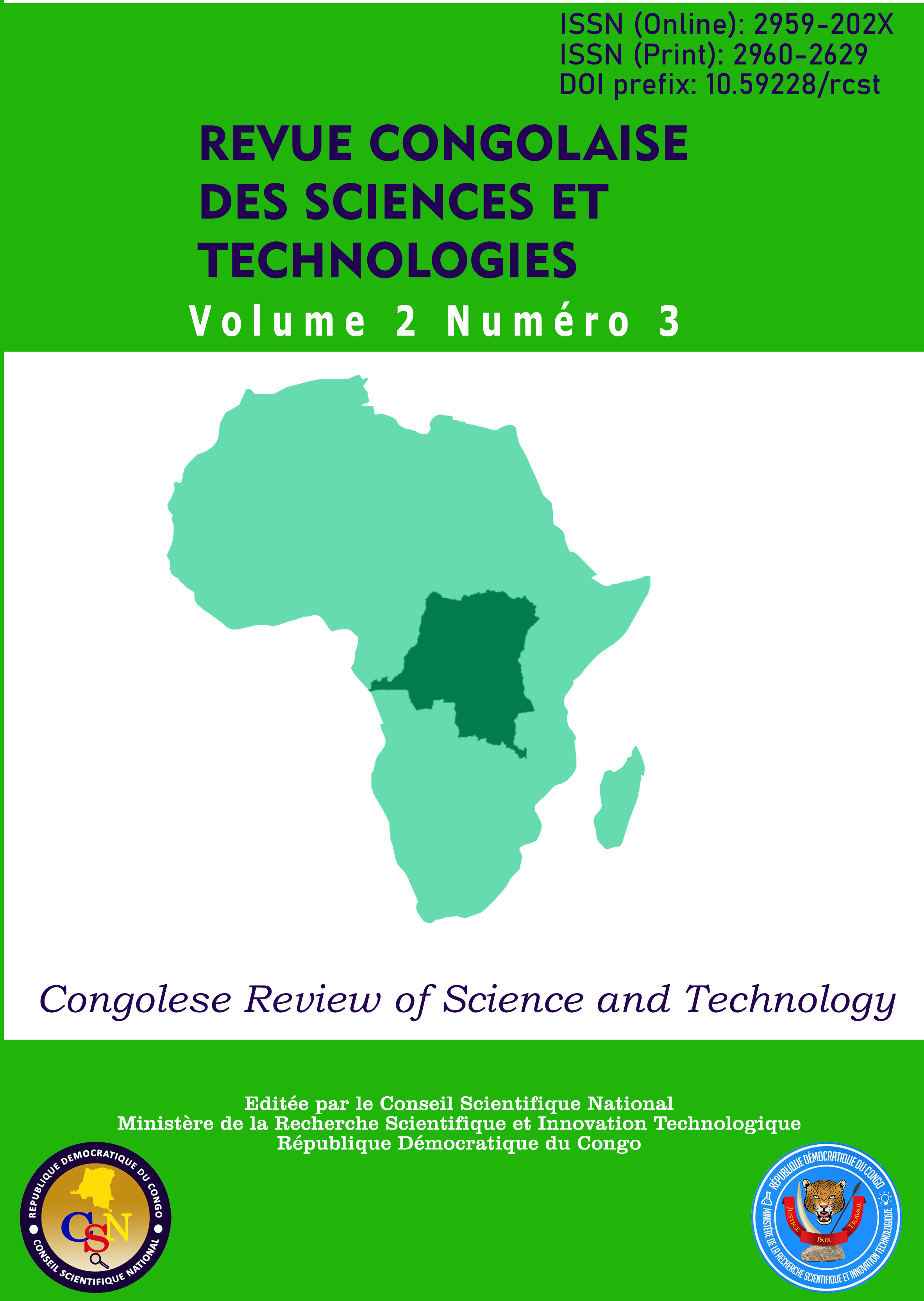Evaluation de la capacité antioxydante d'un aliment de complément à base de ressources traditionnelles : le cas de la Vamine®
Main Article Content
Abstract
The evaluation of antiradicalaire and antioxidant activities of Vamine®
and its constituants has allowed us de constate that the
the evaluation of the anti-free radical and antioxidant activity of Vamine®
and its constituents, allowed us to note that the
capacity of trapping of the free radicals of Vamine®
is pronounced compared to the constituents evaluated separately. Indeed,
Vamine®
has an IC50 value at ABTS of 96.16 ± 5.47 µg / ml compared to Dioscorea bulbifera (150.44 ± 9.64 µg / ml), Corn
(150.44 ± 9.64 µg / ml), Cassava (218.27 ± 12.4 µg / ml), Voandzou (150.31 ± 4.93 µg / ml) Peanuts (338.06 ± 133.59 µg /
ml) and control gallic acid (0.71 ± 0.08 µg / ml). In view of these results, we can assume that the trapping capacity of
Vamine®
comes from the synergy obtained from the mixture of different constituents. The analysis carried out with the radical
DPPH did not show good values of IC50 this could be explained by the fact that for the reactions with DPPH, only the polar
molecules react while the reactions with the radical ABTS relate to the polar molecules and nonpolar.
Article Details

This work is licensed under a Creative Commons Attribution-NonCommercial-ShareAlike 4.0 International License.
References
Abdullah,N., Ismail, S.M., Aminudin, N., Shuib,
A.S., Lau, B.F. (2012). Evaluation of selected
culinary-medicinal mushrooms for antioxidant
and ACE inhibitory activities.Arnao & Cano (2001). The hydrophilic and lipophilic
contribution to total antioxidant activity. Food
Chem, 73, 239-244.
Atrous, T.H. (2011). Etude des propriétés
rhéologiques et microstructurales des amidons
de blé et de pomme de terre irradié. [Mémoire
de Master].
Bhandari, M.R. & Kawabata, J. (2004). Organic acid,
phenolic content and antioxidant activity of wild
yam (Dioscorea spp.) tubers of Nepal. Food
Chem, 88, 163-168.
Bukatuka, F.C., Ngombe, K.N., Mutwale, K.P.,
Moni1, B.M., Makengo, K.G., Pambu, L.A.,
Bongo, N.G., Mbombo, M.P., Musuyu, M.D.,
Maloueki, U., Ngbolua, K.N., Mbemba, F.T.
(2016). Bioactivity and Nutritional Values of
Some Dioscorea Species Traditionally Usedas
Medicinal Foods in Bandundu, DR Congo.
European Journal of Medicinal Plants, 14(1), 1-
Camara, F., Brou, K., Assemand, E.F., Tano, K.,
Dago, G. (2009). Quantification of the energy,
Iron Intake and the Promoter and Inhibitors
Absorption in Rural and Urban Côte d’Ivoire.
European Journal of Scientific Research, 35(1),
-141
Dejianhuang, B. & Ronald, P. (2005). The Chemistry
behind Antioxidant Capacity Assays. J. Agric.
Food Chem, 53, 1841-1856.
Delpeuch, F., Favier, J.C., Charbonniere, R. (1978).
Caractéristiques des amidons de plantes
alimentaires tropicales. Am. Tecknol. agric.,
(4), 809-826.
EDSCI. (2012). Enquête Démographique et de Santé
et à Indicateurs Multiples. Rapport Préliminaire,
Côte d’Ivoire.
Ezzati, M., Loez, A.D., Vander, H.S., Murray, C.J.L.
(2002). Selected major risk factors and global
and regional burden of disease. Lancet, 360,
-1360.
FAO. (1970). Table de composition des aliments à
l’usage de l’Afrique.pp218.
FAO. (2009). La situation mondiale de l’alimentation
et de l’agriculture.
http//www.fao.org/datalog/Inter-htm. Rome,
p.
FAO/OMS. (2008). Programme mixte FAO/OMS sur
les norms alimentaires. Commission du Codex
Alimentarius, 32ème session Rome (Italie), 29
juin-4 juillet 2009. Rapport de la 30ème session
du comité du codex sur la nutrition et les
aliments diététiques ou de régime. Le Cap
(Afrique du Sud).
FAO/OMS. (2006). Norme du codex pour les
aliments transformés à base de céréales destinés
aux nourrissons et enfants en bas âge codex stan
-1981, rév. 1 – 2006.Franck, T., Mouithys-Mickalad, A., Robert, T.,
Ghitti, G., Deby-Dupont, G., Neven, P., &
Serteyn, D. (2013). Differentiation between
stoichiometric and anticatalytic antioxidant
properties of benzoic acid analogues: A
structure/redox potential relationship study.
Chemico-Biological Interactions, 206(2), 194–
Fréderich. (2011). Notes de Micrographie appliquée
à l’étude de la pharmacognosie. 3ème BAC
Pharmacie.
Hélène, A. (2005). Nanocristaux d’amidon de maïs
cireux pour applications composites [Thèse de
Doctorat, Université Joseph Fourier – Grenoble
Hooper, L. & Aedin, C. (2006). A review of the
health care potential of bioactive compounds. J
Sci Food Agric, 86, 1805–1813
Kayodé, A.P.P., Akogou, F.U.G, Amoussa, H.,
Hounhouigan, D.J. (2012). Effets des procédés
de transformation sur la valeur nutritionnelle
des formulations de bouillies de complément à
base de sorgho. Int. J. Biol. Chem. Sci., 6(5):
-2201.
Lee, J.W. & Davis, J.M. (2011). Future applications
of antioxidants in premature infants. Curr Opin
Pediatr., 23(2):1616.
Doi:10.1097/MOP.0b013e3283423e51.
Malvika, B. & Rajinder, K.G. (2015). Formulation,
nutritional and phytochemical analysis of ready
to mix infant Food using Gorgon Nut, Samak
Rice and Banana powder. Journal of
Pharmacognosy and Phytochemistry, 4(4), 76-8.
Mbemba, F. & Remacle, J. (1992). Inventaire et
composition chimique des aliments et denrées
alimentaires traditionnelles du Kwango-Kwilu
au Zaïre. Namur, Presse Universitaire de
Namur.
Memina, S. (1994). La production artisanale de
farines infantiles : Expériences et procédés.
Paris, Editions du Gret.
Mona, R.M., Abeer, M.E., Hala, A.M., Mohamed,
N.U. (2011). Improvement of nutritional quality
and antioxidant activities of yeast fermented
soybean curd residue. African. Journal of
Biotechnology, 10(30), 5750-5759,
Puttaraju, N.G., Venkateshaiah, S.U., Dharmesh,
S.M., Urs, S.M.N. & Somasundaram, R. (2006).
Antioxidant activity of indigenous Edible
Mushrooms. Journal of Agricultural and Food
Chemistry, 54, 9764-9772.
Ruel, M.T. & Harimond, M. (2003). Diversification
alimentaire, couverture des besoins nutritionnels
et croissance des enfants: Connaissances
actuelles et recherches nécessaires. Proceedings
of the 2nd international workshop, Food-basedapproaches fora healthy nutrition in West
Africa: The role of food technologists and
nutritionists. 23-28 November. Ouagadougou,
Burkina Faso. In press.
Sadeghi, N., Jannat, B., Oveisi, M.R., Hajimahmoodi,
M., Photovat, M. (2010). Antioxidant activity of
Iranian pomegranate (Punica granatum L.) seed
extracts. Journal of Agricultural Science and
Technology, 11, 633-638
Sandberg, A.S. (2002). Bioavailability of minerals in
legumes. British Journal of Nutrition, 88, S281-
S2855.
Saskia, V.G. & Annoek, V.W. (2005). La production
artisanale d’aliments de complément. Agrodok
nd Ed. Digigrafi, Wageningen, Pays-Bas :
Fondation Agromisa, Wageninge, 88p.
Shailenra, S. G., Nilambari, S. (2014). Indian Herbal
Drug Microscopy. New York, Springer Science
and Business Media.
Sioibe., 0., Sako, A., Agbo, N. (2007). Etude de
quelques propriétés physico-chimiques des
amidons de cinq (5) variétés de maniocs
(Attiéké Mossi1, Attiéké Mossi2, Agbablé1,
Kétévie et TA(S)} cultivées en Côte-d’Ivoire.
Sciences et Médecine. Rev. CAMES, Série A,
Vol. OS.
Songré-Ouattara, L.T., Kourfom, G., Aly, S.,
Bationo, F., Diawara, B. (2016). Evaluation de
l’aptitude nutritionnelle des aliments utilisés
dans l’alimentation complémentaire du jeune
enfant au Burkina Faso. J. Soc. Ouest-Afr.
Chim., 41, 41- 50.
Soro, S., Elleingand, F.E., Koffi, M.G., Koffi, E.,
(2014). Evaluation des propriétés antioxydantes
et biologiques de farines infantiles à base
d’igname/soja/sources végétales de minéraux.
Journal of Applied Biosciences, 80,7031 – 7047.
UNICEF. (2004). The state of the World’s children.
Rome, UNICEF.
Wagner, H., Bauer, R., Melchart, D., Xioa, P.G.,
Staudinger, A. (2013). Chromatographic
Fingerprint Analysis of Herbal Medicinal: Thinlayer high performance liquid chromatography
of chinese drugs. New York, Springer
International Publishing.
Yang, R.Y. & Tsou, S.C.S. (2006). Enhancing
ironbioavailability of vegetables through proper
preparation principles and applications. Journal
of International Cooperation, 1,107−119.
Zannou, T.V., Bouaffou, K.G, Kouame, K.G., Konan
& B.A. (2011). Etude de la valeur nutritive de
farines infantiles à base de manioc et de soja
pour enfant en âge de sevrage. Bulletin de la
Société Royale des Sciences de Liège, 80, 748-

